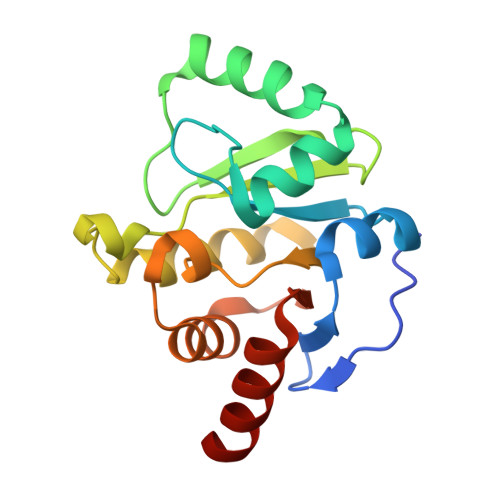Binding Adaptation of GS-441524 Diversifies Macro Domains and Downregulates SARS-CoV-2 de-MARylation Capacity.
Tsika, A.C., Gallo, A., Fourkiotis, N.K., Argyriou, A.I., Sreeramulu, S., Lohr, F., Rogov, V.V., Richter, C., Linhard, V., Gande, S.L., Altincekic, N., Krishnathas, R., Elamri, I., Schwalbe, H., Wollenhaupt, J., Weiss, M.S., Spyroulias, G.A.(2022) J Mol Biol 434: 167720-167720
- PubMed: 35839840
- DOI: https://doi.org/10.1016/j.jmb.2022.167720
- Primary Citation of Related Structures:
7P27, 7QG7 - PubMed Abstract:
Viral infection in cells triggers a cascade of molecular defense mechanisms to maintain host-cell homoeostasis. One of these mechanisms is ADP-ribosylation, a fundamental post-translational modification (PTM) characterized by the addition of ADP-ribose (ADPr) on substrates. Poly(ADP-ribose) polymerases (PARPs) are implicated in this process and they perform ADP-ribosylation on host and pathogen proteins. Some viral families contain structural motifs that can reverse this PTM. These motifs known as macro domains (MDs) are evolutionarily conserved protein domains found in all kingdoms of life. They are divided in different classes with the viral belonging to Macro-D-type class because of their properties to recognize and revert the ADP-ribosylation. Viral MDs are potential pharmaceutical targets, capable to counteract host immune response. Sequence and structural homology between viral and human MDs are an impediment for the development of new active compounds against their function. Remdesivir, is a drug administrated in viral infections inhibiting viral replication through RNA-dependent RNA polymerase (RdRp). Herein, GS-441524, the active metabolite of the remdesivir, is tested as a hydrolase inhibitor for several viral MDs and for its binding to human homologs found in PARPs. This study presents biochemical and biophysical studies, which indicate that GS-441524 selectively modifies SARS-CoV-2 MD de-MARylation activity, while it does not interact with hPARP14 MD2 and hPARP15 MD2. The structural investigation of MD•GS-441524 complexes, using solution NMR and X-ray crystallography, discloses the impact of certain amino acids in ADPr binding cavity suggesting that F360 and its adjacent residues tune the selective binding of the inhibitor to SARS-CoV-2 MD.
Organizational Affiliation:
Department of Pharmacy, University of Patras, GR-26504 Patras, Greece. Electronic address: https://twitter.com/@katerina_tsika.
















